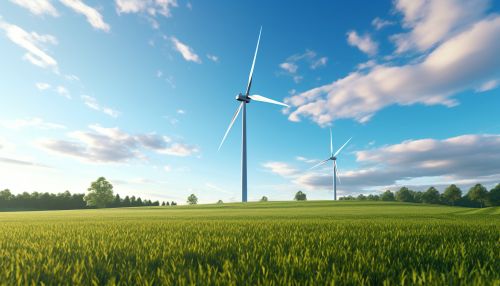Wind Turbine Design
Introduction
Wind turbine design is the process of defining the form and specifications of a wind turbine to extract energy from the wind. A wind turbine installation consists of the necessary systems needed to capture the wind's energy, point the turbine into the wind, convert mechanical rotation into electrical power, and other systems to start, stop, and control the turbine.
Design Considerations
In designing wind turbines, several factors come into play. These include the wind speed, altitude, and terrain, among others. The design also depends on the purpose of the turbine, whether for utility-scale electricity production, small-scale power production, or for water pumping.
Wind Speed and Energy
The amount of energy that a wind turbine can harness from the wind depends on the wind speed. The wind speed varies with altitude and over the day. The design of a wind turbine therefore has to account for the wind speed at the site where the turbine will be installed.
Turbine Types
There are two main types of wind turbines: horizontal axis wind turbines (HAWTs) and vertical axis wind turbines (VAWTs). HAWTs are the most commonly used type, while VAWTs are used in specific situations where the wind direction is highly variable or for aesthetic reasons.
Horizontal Axis Wind Turbines


HAWTs have the main rotor shaft and electrical generator at the top of a tower, and they must be pointed into the wind. Small turbines are pointed by a simple wind vane, while large turbines generally use a wind sensor coupled with a servo motor. To protect against damage from high wind speeds, they are usually equipped with a mechanical or hydraulic brake that can stop the rotor mechanically, electrically, or hydraulically.
Components
HAWTs consist of several components: the rotor, which includes the blades and the hub; the nacelle, which includes the generator, gearbox, and other components; and the tower, which supports the rotor and nacelle.
Rotor
The rotor is the part of the wind turbine that captures the wind energy. The rotor includes the blades and the hub, which holds the blades in place. The design of the blades is crucial for the efficiency of the wind turbine. The blades are usually made of composite materials such as fiberglass.
Nacelle
The nacelle contains the key components of the wind turbine, including the gearbox, generator, and control system. The gearbox increases the rotational speed from the rotor to the high-speed rotation needed to generate electricity. The generator converts the mechanical energy from the wind into electrical energy.
Tower
The tower supports the rotor and nacelle. It is designed to be strong enough to withstand the wind loads and the weight of the nacelle and rotor, yet flexible enough to bend with the wind to avoid resonant frequencies that could cause structural failure.
Vertical Axis Wind Turbines
VAWTs have the main rotor shaft arranged vertically. The main advantage of this arrangement is that the wind turbine does not need to be pointed into the wind. This is an advantage on sites where the wind direction is highly variable. VAWTs are also generally more compact and can be installed closer to the ground, making them easier to maintain.
Design Process
The design process for a wind turbine involves several steps. First, the site conditions are assessed, including the wind speed and direction, the terrain, and any obstacles. Then, the design requirements are defined, such as the power output and the operational life of the turbine. The design of the turbine is then carried out, including the design of the rotor, the nacelle, and the tower. Finally, the design is tested, both in computer simulations and in wind tunnel tests.
